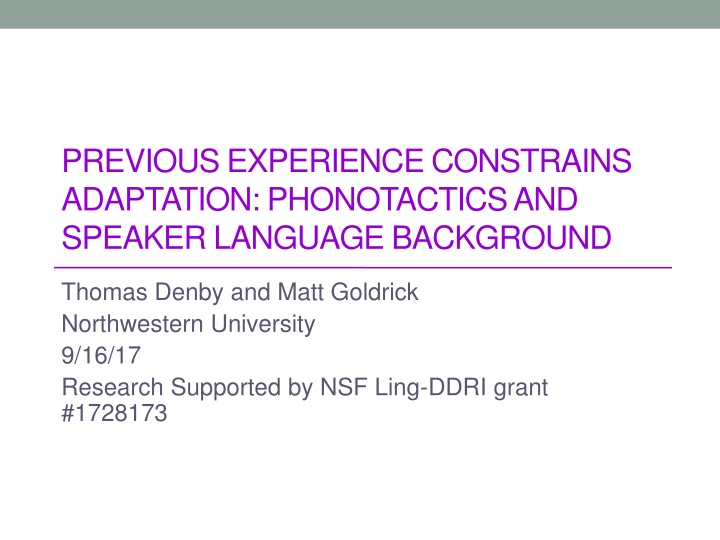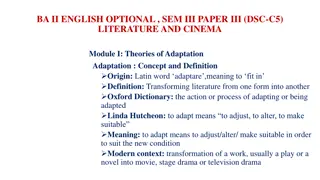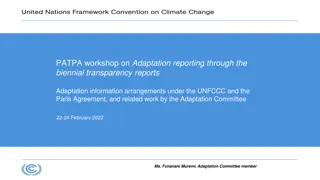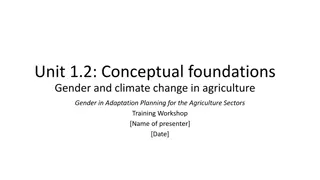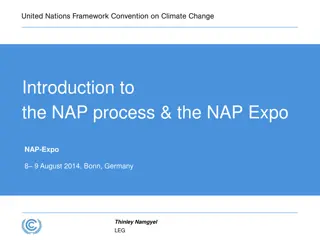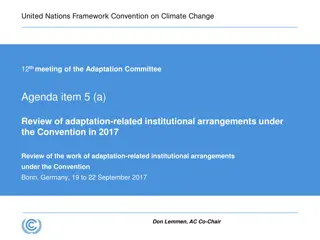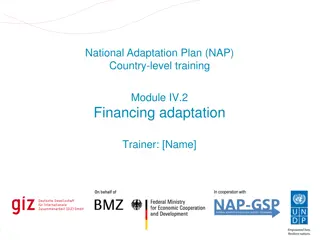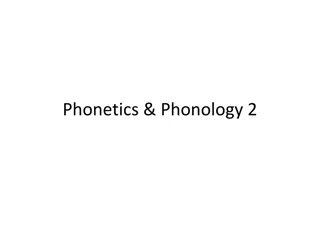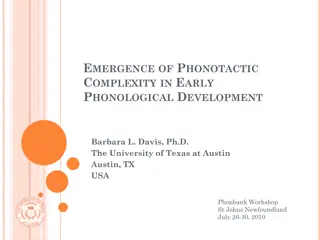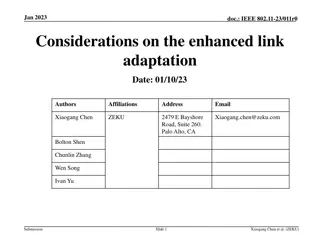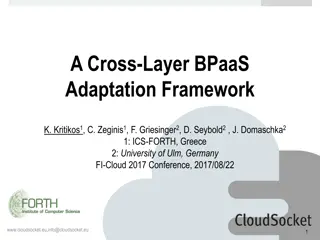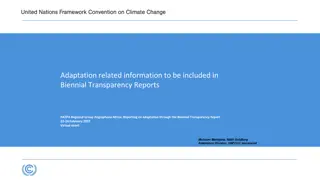Phonotactic Adaptation in Language Learning
Phonotactic adaptation involves how our prior experience with phonotactic variation influences our ability to adapt to novel phonotactics. The research explores phonotactic constraints on sound sequences and the impact of speaker language background on adaptation.
Download Presentation

Please find below an Image/Link to download the presentation.
The content on the website is provided AS IS for your information and personal use only. It may not be sold, licensed, or shared on other websites without obtaining consent from the author.If you encounter any issues during the download, it is possible that the publisher has removed the file from their server.
You are allowed to download the files provided on this website for personal or commercial use, subject to the condition that they are used lawfully. All files are the property of their respective owners.
The content on the website is provided AS IS for your information and personal use only. It may not be sold, licensed, or shared on other websites without obtaining consent from the author.
E N D
Presentation Transcript
PREVIOUS EXPERIENCE CONSTRAINS ADAPTATION: PHONOTACTICS AND SPEAKER LANGUAGE BACKGROUND Thomas Denby and Matt Goldrick Northwestern University 9/16/17 Research Supported by NSF Ling-DDRI grant #1728173
2 Phonotactics Constraints on sound sequences within syllables and words Constraints vary between languages e.g. English: [s ] but *[ s] Vietnamese [ ] ( sleep ) Variation in phonotactic constraints not characteristic of individual talkers (Pierrehumbert, 2001)
Phonotactic adaptation In experimental settings, listeners quickly learn novel constraints (e.g. syllables cannot end in voiceless stops ) Listeners make more false memory errors for syllables that follow, rather than violate, experimental constraint (Denby, et al, in press) Adaptation effects also appear in speech errors (Dell, et al, 2000) and repetition times (Onishi, Chambers, and Fisher, 2002)
Big question How does our prior experience with phonotactic variation constrain adaptation to novel phonotactics?
Big question How does our prior experience with phonotactic variation constrain adaptation to novel phonotactics? Hypothesis Listeners adapt to systematic variation while ignoring irrelevant variation using their prior experience
Big question How does our prior experience with phonotactic variation constrain adaptation to novel phonotactics? Hypothesis Listeners adapt to systematic variation while ignoring irrelevant variation using their prior experience E.g. variation in consonant production due to individual variation/dialect vs. speaker with disrupted production due to pen in mouth (Kraljic, Samuel, & Brennan, 2008)
Big question How does our prior experience with phonotactic variation constrain adaptation to novel phonotactics? Hypothesis Listeners adapt to systematic variation while ignoring irrelevant variation using their prior experience Prior experience systematic phonotactic variation between speakers of different languages, little variation between speakers of the same language/dialect
Big question How does our prior experience with phonotactic variation constrain adaptation to novel phonotactics? Predictions Talker-specific phonotactic constraints (e.g. 2 speakers of English) lower degree of adaptation Language-specific constraints (1 English speaker vs. 1 French speaker) greater degree of adaptation
9 Recognition Memory Task Listeners hear a series of nonsense syllables without breaks No explicit information about talkers included Prompt: Have you heard this sound before? After stimulus plays: respond YES or NO Listeners asked to track nonsense syllables in memory Can probe learnability of constraints (Bernard, 2015, 2017; Steele, et al., 2015; Denby et al., in press)
10 Recognition Memory No fricatives in coda; stops unrestricted Phase I: Familiarization Expose listeners to repeated instances following constraint pak, sut, kut, ap, kut, pak, tap
11 Recognition Memory No fricatives in coda; stops unrestricted Phase II: Generalization Expose listeners to occasional novel generalization syllable tap, sut, pak, puk, kut, tus, ap
12 Recognition Memory No fricatives in coda; stops unrestricted Phase II: Generalization Expose listeners to occasional novel generalization syllable tap, sut, pak, puk, kut, tus, ap Legal (follows constraint) or illegal (violates constraint) Do participants incorrectly respond yes more often on legal syllables?
13 Experiment Overview English listeners exposed to talker-specific constraints E.g. Speaker A does not end their syllables in fricatives; speaker B doesn t end their syllables in stops Experiment 1 Preregistered with Open Science Foundation Number of participants set to maximize power ( = .804) Determined by Monte Carlo simulations based on results from pilot study Experiment 2 Follow-up study
14 Experiment 1 Overview English listeners exposed to talker-specific constraints 4 conditions Native Shared Non-Native Shared Weak Different Strong Different Shared English [i, u] [i, u] Shared French [i, y] [i, y] English vs. French [i, u] [i, u] English vs. French [i, y] [i, u] Language Background French vs. English vowels
15 Experiment 1 Overview English listeners exposed to talker-specific constraints 4 conditions Native Shared Non-Native Shared Weak Different Strong Different Shared English [i, u] [i, u] Shared French [i, y] [i, y] English vs. French [i, u] [i, u] English vs. French [i, y] [i, u] Language Background French vs. English vowels Control: Gender Different Different Same Same
16 Methods 64 participants/condition (AMT; passed criteria for attending to task) Stimuli 72 CVC nonsense syllables 6 onsets [s, ,f,t,k,p] * 2 vowels [i,u/y] * 6 codas One speaker ends syllables in fricatives; other speaker in stops (counter-balanced) Procedure Familiarization: 4 reps of 36 syllables Generalization: 9 more reps of familiarization syllables, intermixed with 36 novel generalization syllables (4/block) 504 continuous trials
17 Generalization syllables following familiarization pattern are legal, those that don t are illegal Speaker A: Fricative codas fuf, ki , tis, uf Speaker B: Stop Codas fut, kip, tik, uk Familiarization Generalization - legal Generalization - illegal Adaptation: More false alarms on legal vs. illegal fif, ku , fit, kup tus, tuf, tuk, ship
18 Experiment 1 predicted results
19 Experiment 1 predicted results
20 Experiment 1 results
21 Experiment 1 limitations 1. Familiarization and generalization syllables did not always match All generalization syllables had [i] or [u] (never [y]) May have inhibited adaptation in Strong Different condition 2. French talkers were phonetically dissimilar Different pitch contours across male and female French speakers Female speaker had not recently been in French- dominant environment Listeners may have inferred multiple language backgrounds in NN shared condition
22 Experiment 2 NN shared and Strong different conditions Generalization syllables match familiarization ([y] instead of [u]) Recorded novel French female speaker Imitated French male speaker s utterances Experiment 1 Experiment 2
23 Experiment 2 results
24 Experiment 2 results
25 Experiment 2 results Strong > NN shared > Native shared Both presence of NN speech + language differences adaptation
26 Summary Hypothesis Listeners adapt to systematic variation while ignoring irrelevant variation using their prior experience Listeners show largest degree of adaptation to talker- specific constraints when talkers differ in language background Future work will investigate if listeners are sensitive to differences between non-native languages
27 Summary Hypothesis Listeners adapt to systematic variation while ignoring irrelevant variation using their prior experience Additionally, listeners show moderate adaptation when talkers share a non-native language background Presence of non-native speakers may increase listener confidence that talkers do not share a language background Future work will manipulate strength of non-native language background cues within NN Shared condition
28 Conclusion Phonotactic adaptation is constrained by previous experience Not simply associative pattern learning (Anderson, Holmes, & Dell, 2016) Informed by previous linguistic experience (e.g., Pajak, et al., 2016)
29 Thank you! Thanks to the NSF for their generous funding, and to Jennifer Cole, Ann Bradlow, Melissa Baese-Berk, Chun Chan, and the NU SoundLab for their help and feedback! tdenby [at] u.northwestern.edu sites.northwestern.edu/denby Northwestern University
30 APPENDIX
31 Experiment 2 discussion What s driving the increase in legality advantage for Strong-different condition between Exp1 + 2? Vowel? No: largest increase in legality advantage from Exp1 to 2 for syllables with /i/ Talker? No: similar legality advantage for male and female French talkers Adaptation not driven by English talker in different conditions
32 Experiments 1 + 2 results
33 Experimental criteria
